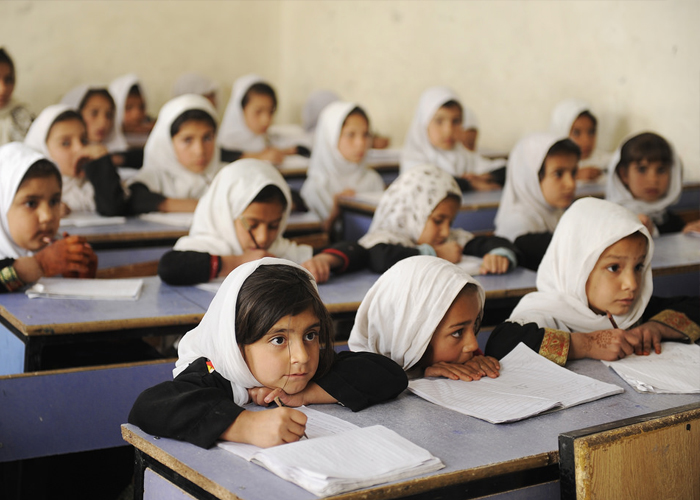Afghanistan had made great efforts in improving access and number of enrolments to primary education but still, there is a long way to go as it requires a lot of efforts and support to achieve great things related to education, several reforms should be initiated to make it possible. In 2016 9.2 million Afghani youth and children were enrolled in the schools, this number was 9 percent greater as compared to the statistics of 2001.
According to provincial analysis, 50 percent of girls in 15 provinces out of 34 provinces of Afghanistan are out school, this looks alarming though overall enrollment number is increasing but there is gender inequality which should be improved.
Only 50 percent of the population between the age of 15 and 24 is educated, there are quality learning issues due to inadequate environment as the teachers remain underqualified.
A lot of resources are needed to prepare the student for joining schools, enrollment growth is on the rise in Afghanistan but education spending has decreased which is also alarming. The eyes are on international elements to invest in educational growth in Afghanistan, this is where World Bank has to play the big role.
The World Bank is playing its part in full swing with the help of other international forces.In the last 10 years, more than 30 universities have been established in the country with help of local government, still, there is a need for reliable infrastructure and a faculty that abandons ancient teaching mythology and adopts the latest trends in the education. According to one of the lecturers at Bamyan University, there is teacher-oriented mythology in Afghanistan where teacher dictates and students listen-only, this is not the latest trend as the world follows interactive sessions and student-centered methodology with a lot of research work included.World Bank has initiated a program to train the higher education faculty of Afghanistan, it is also funding a lot of scholarships at international universities for Afghan students and teachers. There is a big program named “train the trainer initiative” which is working under the vision of higher education development project funded by the World Bank, the purpose of this program is to bring modern teaching mechanisms to the country by training the staff. Universities nominate staff to be part of this program where faculty improve their skills and learn student-centric methods of teaching. This program is running successfully for a few years now. The OBE with the support of SCL training is doing wonders by improving student-teacher interactions.
The World Bank board of directors approved the project named EQRA where they provide an IDA grant of 100 million dollars, ARTF grant of 100 million dollars, and GPE grant of 98 million US dollars. This project is aimed to improve the access to basic level of education which includes primary and secondary education, girls are prioritized in this project because they are very deprived when it comes to education in Afghanistan.
This great project is in action since 2018 and as a result, the enrollment number has increased in Afghanistan but it hasn’t achieved the landmark more girls into the schools. The other significant project funded by World Bank is “education quality improvement program”, this project is based on capacity building and reforms. This will add procurement and lab facility installation in the contracted universities of Afghanistan.
This project will work to rebuild the infrastructure of universities concerning international standards.
There is a need of higher education information development systems and this project is also trying to achieve that landmark. This project has trained the faculty to revise the curriculum.
The outcomes were significant which helped in improving the quality of education in Afghanistan.
This is not ended here, according to government ministry the World Bank has pledged to spend 298 million dollars for the educational development in Afghanistan in the times to come. The World Bank is planning to target the rural areas of the country through the initiative.
The purpose of the project is to assist the Afghan government to eradicate poverty by investing in the future and youth is the future and pillar of the country which can be transformed through true educational reforms. According to a report still 3.7 million out of school children are present in the country which requires the attention of international forces.
According to an official of the World Bank, 7.3 million students who were enrolled in schools in the last decade which was considered as a decade of education, they also seek attention because enrolling them will not solve the problem.
There is a need for quality of education from the basic level that will strengthen the children by true means and will transform them as nation builders in the future.
This project will not be successful without rural rehabilitation and development. There is a need of reconstruction of schools with the help of local government and ministry of education of the country and there is also a need for economic development in such locations because education and economy run simultaneously. If the financial condition of such children and their parents is not improved then they will only try to work for survival, the number of child labor will increase in the country, which will give rise to more out of school children in Afghanistan. This project will cover 5000 villages in five years and almost 6000 schools will be reconstructed.Conclusively World Bank has taken a lot of initiatives to cover the basic as well as higher education of Afghanistan. The organization is working in the right direction to bring the great educational reforms in the country which was torn by so many wars and alarming law and order situations.
Home » Opinion » Development of education in Afghanistan
Development of education in Afghanistan
| Dr. Shabeer Khan

